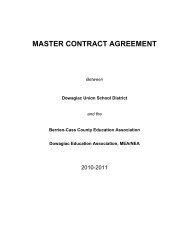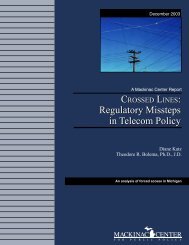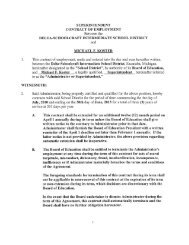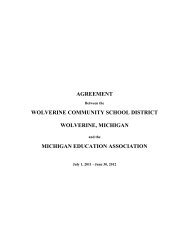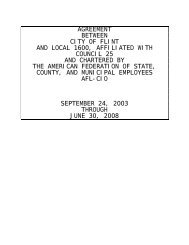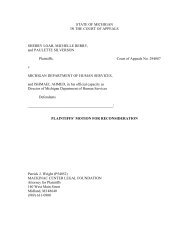The Cost of Remedial Education - Mackinac Center
The Cost of Remedial Education - Mackinac Center
The Cost of Remedial Education - Mackinac Center
Create successful ePaper yourself
Turn your PDF publications into a flip-book with our unique Google optimized e-Paper software.
<strong>The</strong> <strong>Cost</strong> <strong>of</strong> <strong>Remedial</strong> <strong>Education</strong>:<br />
How Much Michigan Pays When Students Fail to Learn Basic Skills<br />
<strong>Mackinac</strong> <strong>Center</strong> for Public Policy<br />
are not successful graduates; that is, by the number <strong>of</strong> students who drop out or have to<br />
enroll in remedial education in college. We further assume that the cost <strong>of</strong> remediation is<br />
proportional to the number <strong>of</strong> grade levels by which the unsuccessful high school students<br />
are behind.<br />
<strong>The</strong> purpose <strong>of</strong> calculating the cost in this way is to capture some <strong>of</strong> the costs that<br />
were missed in the previous strategies. As already described, the true cost <strong>of</strong> remedial<br />
education in post-secondary institutions is likely to be larger than we have previously<br />
estimated because we do not count capital expenditures, because remedial education occurs<br />
outside <strong>of</strong> courses <strong>of</strong>ficially labeled as such, and because many students who need remedial<br />
education do not receive it. By using the amount <strong>of</strong> operating funds that high schools have to<br />
spend to produce a successful graduate, we are more likely to capture the costs <strong>of</strong> remedial<br />
education that occur outside <strong>of</strong> remedial courses. This technique, however, still does not<br />
address the omission <strong>of</strong> capital expenditures nor does it address the undercount <strong>of</strong> students<br />
requiring remedial services. Nevertheless, this less conservative estimate <strong>of</strong> the costs per<br />
FTE student receiving remedial education in community colleges and universities might<br />
provide us with a more complete picture <strong>of</strong> the costs. Using the high school cost should also<br />
provide us with a more realistic estimate <strong>of</strong> the costs imposed on Michigan businesses.<br />
According to the most recent figures available from the Michigan Department <strong>of</strong><br />
<strong>Education</strong>, Michigan public schools spend $4,227 per pupil on instructional services, and<br />
Michigan public high schools contain 476,485 students. 22 On an operating basis (excluding<br />
capital expenditures and non-instructional costs, such as lunch and transportation) Michigan<br />
public high schools spend a total <strong>of</strong> $2,014,102,095 per year. But because <strong>of</strong> dropouts only<br />
91,691 students graduate each year. And <strong>of</strong> those who graduate, 14,848 are likely to enroll<br />
in a year’s worth <strong>of</strong> remedial education in community college or university. 23 In other words,<br />
Michigan public high schools spend about $2 billion each year to produce 76,843<br />
“successful” graduates, meaning graduates who will not require a year <strong>of</strong> remedial education<br />
to address their lack <strong>of</strong> basic skills. Dividing the total amount spent by Michigan public high<br />
schools by the number <strong>of</strong> successful graduates (multiplied by four to account for the fact that<br />
it takes four years to complete high school), yields a per successful graduate cost <strong>of</strong> $6,553<br />
per year (excluding capital and non-instructional expenses).<br />
Michigan public<br />
high schools spend<br />
about $2 billion<br />
each year to<br />
produce 76,843<br />
“successful”<br />
graduates—<br />
graduates who will<br />
not require a year<br />
<strong>of</strong> remedial<br />
education to<br />
address their lack<br />
<strong>of</strong> basic skills.<br />
If we calculate the cost <strong>of</strong> producing “successful” graduates we discover that the<br />
instructional cost <strong>of</strong> Michigan public high schools may be underreported by about 55<br />
percent. When most businesses calculate the cost <strong>of</strong> making their product, they divide their<br />
costs by the number <strong>of</strong> products that can be sold to customers. Businesses do not normally<br />
include those products that were damaged in such a way that they cannot be sold. For<br />
example, a cookie company calculating the cost <strong>of</strong> manufacturing each cookie would not<br />
count those cookies that were damaged in production. While students are not cookies, the<br />
22<br />
23<br />
Michigan Department <strong>of</strong> <strong>Education</strong>. Available at http://www.mde.state.mi.us/reports/msr/index98.shtml;<br />
accessed on August 18, 2000. This figure is for instructional costs only and does not include<br />
capital expenditures or extra programs, such as school lunch, transportation, etc. (Click on “1998<br />
School Report in PDF format” and see “State Avg Bldg Data.”) Since these costs do not apply in<br />
post-secondary institutions, this lower per-pupil figure is the most reasonable to use.<br />
Actually more students than this will enroll for less than a year’s worth <strong>of</strong> courses. This figure is<br />
the full-time equivalent <strong>of</strong> students who will enroll in remedial courses.<br />
September 2000 13




